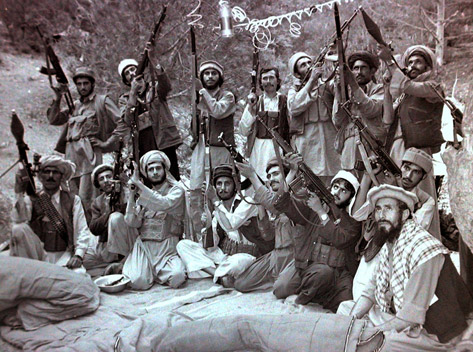
The First Afghan War
Causes and Processes
The object of failed Russian and British conquests during the 19th century, Afghanistan was a largely mountainous, arid and landlocked tribal region. During the 20th century the USSR repeatedly tried to interfere in Afghan politics in an attempt to subjugate Afghanistan.
The USSR saw that Mohammed Daoud Khan, who overthrew the monarchy in 1976 with Soviet aid, was attempting to break free from the Soviet yoke, so the USSR backed Nur Muhammad Taraki, leader of the People’s Democratic Party of Afghanistan, in his coup against Daoud. This was in April 1978.
Taraki carried out drastic reforms and launched pro-Soviet policies. In 1978 Taraki signed an agreement with the USSR, which permitted the USSR to send troops into Afghanistan if requested. The following year Hafizullah Amin was appointed as Premier, but the USSR did not approve of him. The USSR attempted to join forces with Taraki to remove him, but Amin killed Taraki first and became President. Amin also tried to get close to the US.
Moscow feared that it was losing control over Afghanistan. The government had attempted modernizing reforms that caused many armed revolts and government purges. The Afghan government met with increasing resistance, and asked for USSR assistance. The USSR sent troops into Afghanistan.
Invasion
From December 1979 – January 1980, troops and jets were sent into Afghanistan in large numbers from the USSR’s Central Asian republics. The Soviet plans were to capture Afghan urban centres and Afghan government strongholds and thus cause armed resistance to collapse. Important border crossings with other nations were also captured.
On December 27 1979, USSR agents assassinated Amin.
The invasion caused the Afghans to rise up in revolt against the Soviet invaders, and nationalistic feelings climaxed. Many regional mujahideen (religious fighter groups) in Afghanistan received sponsorship from the US, Pakistan, Saudi Arabia and other US allies. The invasion was widely condemned by other nations and the UN, and the USSR was asked to withdraw its troops.

(Mujahedin in 1984)
As the war escalated there were up to 120,000 Soviet troops and 70,000 government troops, and there were up to 100,000 mujahideen. The Soviets planned major operations to wipe out the mujahideen in Afghanistan, but they failed. The mujahideen, with foreign sponsorship, were able to use the harsh but familiar terrain to their advantage. Coupled with advanced weapons from its donors, the mujahideen were able to engage in guerrilla warfare. The Soviet Army discovered it to be fighting a losing war, and resorted to negotiations.
As Gorbachev came to power in 1985 he gradually scaled down the warfare, transferred more operations to the Kabul government’s army, and began pulling Soviet troops back into the USSR. By 1989 the USSR had fully pulled out of Afghanistan, and the war ended.
Did Gorbachev do the right thing in withdrawing the Soviet troops from Afghan?
ReplyDelete